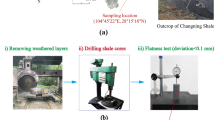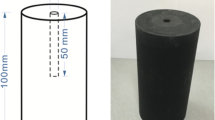Abstract
We performed hydraulic fracturing experiments on cylindrical cores of anisotropic shale obtained by drilling normal to the sedimentary plane. Experiments were conducted under ambient condition and uniaxial stresses, using three types of fracturing fluid: viscous oil, water, and liquid carbon dioxide (L-CO2). In the experiments using water and oil, cracks extended along the loading direction normal to the sedimentary plane under the uniaxial loading and extended along the sedimentary plane without loading. These results suggest that the direction of crack extension is strongly affected by in situ stress conditions. Fluorescent microscopy revealed that hydraulic fracturing with viscous oil produced linear cracks with few branches, whereas that with water produced cracks with many branches inclining from the loading axis. Statistical analysis of P wave polarity of acoustic emission waveforms showed that viscous oil tended to induce Mode I fracture, whereas both water and L-CO2 tended to induce Mode II fracture. Crack extension upon injection of L-CO2 was independent of loading condition unlike extension for the other two fluids. This result seemed attributable to the low viscosity of L-CO2 and was consistent with previous observations for granite specimens that low-viscosity fluids like CO2 tend to induce widely extending cracks with many branches, with Mode II fractures being dominant. These features are more advantageous for shale gas production than those induced by injection of conventional slick water.











Similar content being viewed by others
References
Amadei B, Stephansson O (1977) Rock stress and its measurement. Chapman & Hall, London
Arthur JD, Bohm B, Layne M (2008) Hydraulic fracturing considerations for natural gas wells of the Marcellus shale. In: Proceedings of the ground water protection council annual forum, Cincinnati, Ohio
Cleary J (1958) Hydraulic fracture theory part II—fracture orientation and possibility of fracture control. Division of the Illinois state geological survey, circular 252
Graham CC, Stanchits S, Main I, Dresen G (2010) Comparison of polarity and moment tensor inversion methods for source analysis of acoustic emission data. Int J Rock Mech Min Sci 47:161–169
Haimson BC, Cornet FH (2003) ISRM suggested methods for rock stress estimation—Part 3: hydraulic fracturing (HF) and/or hydraulic testing of pre-existing fractures (HTPF). Int J Rock Mech Min Sci 40:1011–1020
Hubbert M, Willis DG (1957) Mechanics of hydraulic fracturing, petroleum transactions. AIME 210:153–168
Ishida T, Chen Q, Mizuta Y, Roegiers J-C (2004) Influence of fluid viscosity on the hydraulic fracturing mechanism, Transactions of the ASME. J Energy Resour Technol 126:190–200
Ishida T, Aoyagi K, Niwa T, Chen Y, Murata S, Chen Q, Nakayama Y (2012) Acoustic emission monitoring of hydraulic fracturing laboratory experiment with supercritical and liquid CO2. Geophys Res Lett 39:L16309. doi:10.1029/2012GL052788
Ishida T, Nagaya Y, Inui S, Aoyagi K, Nara Y, Chen Y, Chen Q, Nakayama Y (2013) AE monitoring of hydraulic fracturing experiments with CO2 and water. In: Proceedings of Eurock2013, Wroclaw, Poland, 957–962
Kalantari-Dahaghi A (2010) Numerical simulation and modeling of enhanced gas recovery and CO2 sequestration in shale gas reservoirs: a feasibility study. In: Proceedings of international conference on CO2 capture, storage, and utilization, Society of Petroleum Engineeers, New Orleans, La
Nishiyama T, Kusuda H (1994) Identification of pore spaces and micro cracks using fluorescent resins. Int J Rock Mech Min Sci Geomech Abstr 31(4):369–375
Nuttall BC (2006) Sequestration in gas shale of Kentucky. In: Proceedings of 5th annual conference on carbon capture and sequestration, Alexandria, Virginia, USA, Poster No. 106
Schmitt DR, Zoback MD (1989) Poro-elastic effects in the determination of the maximum horizontal principal stress in hydraulic fracturing tests-a proposed breakdown equation employing a modified effective stress relation for tensile failure. Int J Rock Mech Min Sci Aeromech Abstr 26:499–506
Sun K, Tan J, Wu D (2011) The research on dynamic rules of crack extension during hydraulic fracturing for oil shale in situ exploitation. International conference on environmental science and engineering (ICESE 2011). Proc Environ Sci 12(2012):736–743
Zang A, Stephansson O (2010) Stress field of the earth’s crust. Springer, Berlin (ISBN 978-1-4020-8444-7)
Zang A, Wagner FC, Stanchits S, Dresen G, Andresen R, Haidekker MA (1998) Source analysis of acoustic emissions in Aue granite cores under symmetric and asymmetric compressive loads. Geophys J Int 135:1113–1130
Zoback MD, Rummel F, Jung R, Raleigh CB (1977) Laboratory hydraulic fracturing experiments in intact and pre-fractured rock. Int J Rock Mech Min Sci Geomech Abstr 14:49–58
Acknowledgments
The authors wish to acknowledge the invaluable support offered by Kushiro Coal Mine Co. Ltd. by providing the shale blocks that were used to prepare the cores for the experiments in this study.
Author information
Authors and Affiliations
Corresponding author
Rights and permissions
About this article
Cite this article
Bennour, Z., Ishida, T., Nagaya, Y. et al. Crack Extension in Hydraulic Fracturing of Shale Cores Using Viscous Oil, Water, and Liquid Carbon Dioxide. Rock Mech Rock Eng 48, 1463–1473 (2015). https://doi.org/10.1007/s00603-015-0774-2
Received:
Accepted:
Published:
Issue Date:
DOI: https://doi.org/10.1007/s00603-015-0774-2




